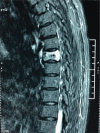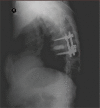Primary Ewing's sarcoma of the vertebral body: A case report
- PMID: 31192925
- PMCID: PMC6587662
- DOI: 10.1097/MD.0000000000015905
Primary Ewing's sarcoma of the vertebral body: A case report
Abstract
Rational: The occurrence of Ewing's sarcoma in the vertebral body of elderly women is extremely rare, and the case of Ewing's sarcoma in the spine with secondary surgical repair after wrong diagnosis and treatment has not been reported. We report a case involving primary Ewing's sarcoma of the vertebral body in an elderly female. Owing to its rarity and controversial issues, we report a case report to discuss its clinical features, treatments, radiological, and histological characteristics.
Patient concerns: The elderly female patient came to see us with the manifestation of total paralysis of both lower limbs. The patient with a vertebral compression fracture as the primary manifestation was misdiagnosed in another hospital. The patient underwent inappropriate surgical treatment and was transferred to our hospital for diagnosis and second-stage surgery.
Diagnoses: The postoperative pathological examination and immunohistochemical examination in our hospital confirmed: Ewing's sarcoma; Surgical history at other hospitals suggests: after Bone cement injection.
Interventions: The patient underwent a T6 and T8 laminectomy and T5/6-T9 pedicle screw fixation.
Outcomes: Reexamination 1 month after the surgery showed that the tumor had been partially resected, the spinal cord compression was relieved, the tumor did not grow further, and the patient's lower limb physical ability, tactile sense, algesia and temperature sense recovered slightly.
Lessons: For patients with ewing's tumor in the spinal canal with symptoms of spinal cord compression, even if the patients with poor results after a unadvisable operation, it is still necessary to be actively in spinal cord compression by surgery. The differential diagnosis of Ewing's sarcoma and compression fractures is very important. For patients with vertebral tumors, special attention should be taken during vertebroplasty for bone cement leakage caused by excessive bone cement injection and increased local pressure. And some experience with imaging and laboratory findings.
Conflict of interest statement
The authors have no conflicts of interest to disclose.
Figures






Similar articles
-
Primary Ewing's Sarcoma of the Spine: About a Case.Glob Pediatr Health. 2022 Nov 17;9:2333794X221123874. doi: 10.1177/2333794X221123874. eCollection 2022. Glob Pediatr Health. 2022. PMID: 36420454 Free PMC article.
-
Intradural extramedullary Ewing's sarcoma: A case report and review of the literature.Neurol Neurochir Pol. 2017 Jan-Feb;51(1):106-110. doi: 10.1016/j.pjnns.2016.11.006. Epub 2016 Nov 30. Neurol Neurochir Pol. 2017. PMID: 27939398 Review.
-
Compressive myelopathy and compression fracture of aggressive vertebral hemangioma after parturition: A case report and review of literature.Medicine (Baltimore). 2019 Dec;98(50):e18285. doi: 10.1097/MD.0000000000018285. Medicine (Baltimore). 2019. PMID: 31852104 Free PMC article. Review.
-
CNS involvement in Ewing's sarcoma. A report of 12 cases.Acta Neurochir (Wien). 1991;113(1-2):48-51. doi: 10.1007/BF01402114. Acta Neurochir (Wien). 1991. PMID: 1799143
-
The Ewing's sarcoma of cervical spine-a rare occurrence.Spinal Cord Ser Cases. 2022 Jul 21;8(1):68. doi: 10.1038/s41394-022-00534-6. Spinal Cord Ser Cases. 2022. PMID: 35864101 Free PMC article.
Cited by
-
Unusual Presentation of Thoracic Epidural Ewing Sarcoma in a 20-Year-Old Patient: A Case Report.Cureus. 2024 Jun 22;16(6):e62902. doi: 10.7759/cureus.62902. eCollection 2024 Jun. Cureus. 2024. PMID: 39040728 Free PMC article.
-
Post-Radiotherapy Complications in Ewing Sarcoma: A Case Report and Literature Review.Cureus. 2024 Jan 3;16(1):e51579. doi: 10.7759/cureus.51579. eCollection 2024 Jan. Cureus. 2024. PMID: 38313991 Free PMC article.
References
-
- Chen Xiaoping, Wang Jianping Surgery. 2013;Beijing: People's Medical Publishing House, 800.
-
- Ruiz DSM, Burkhardt K, Jean B, et al. Pathology findings with acrylic implants. Bone 1999;25:85S–90S. - PubMed
-
- Tancioni F, Lorenzetti MA, Navarria P, et al. Percutaneous vertebral augmentation in metastatic disease: state of the art. J Support Oncol 2011;9:4–10. - PubMed
-
- Barr JD, Barr MS, Lemley TJ, et al. Percutaneous vertebroplasty for pain relief and spinal stabilization. Spine 2000;25:923–8. - PubMed
Publication types
MeSH terms
LinkOut - more resources
Full Text Sources

